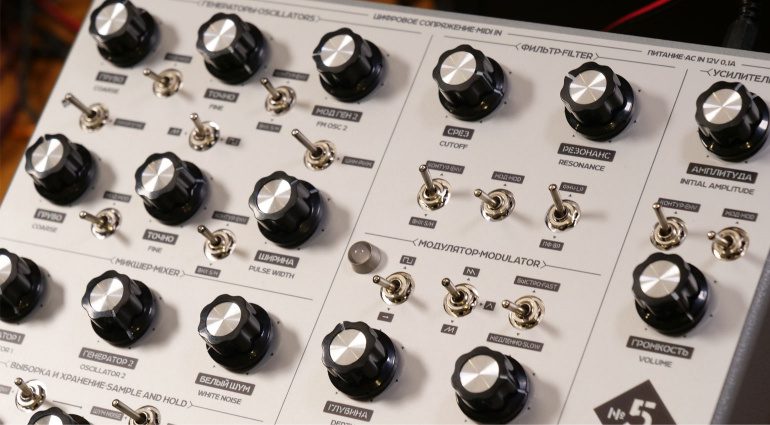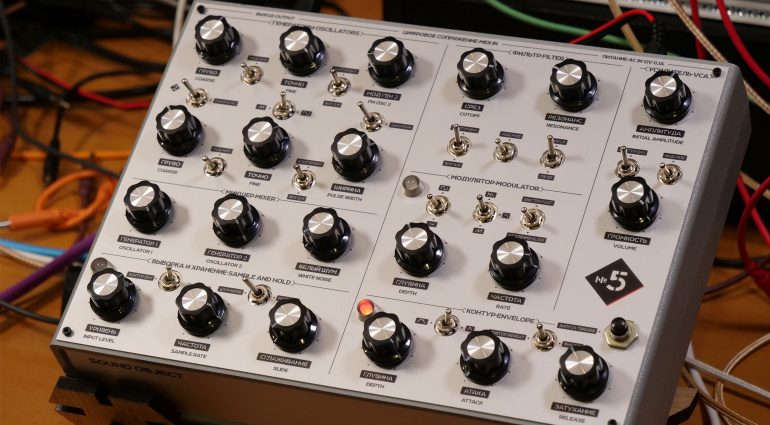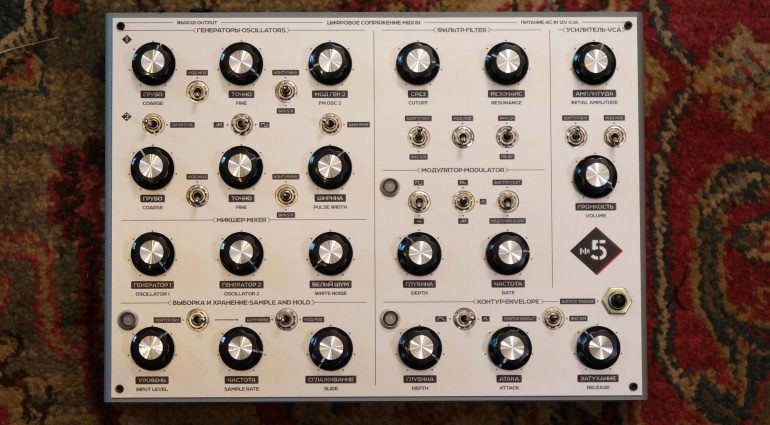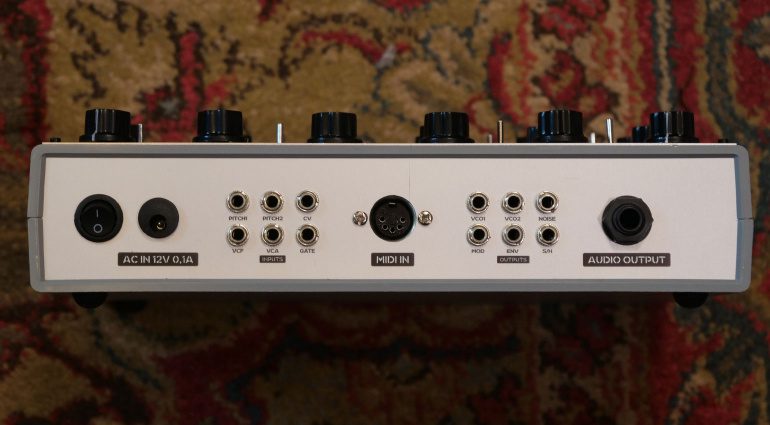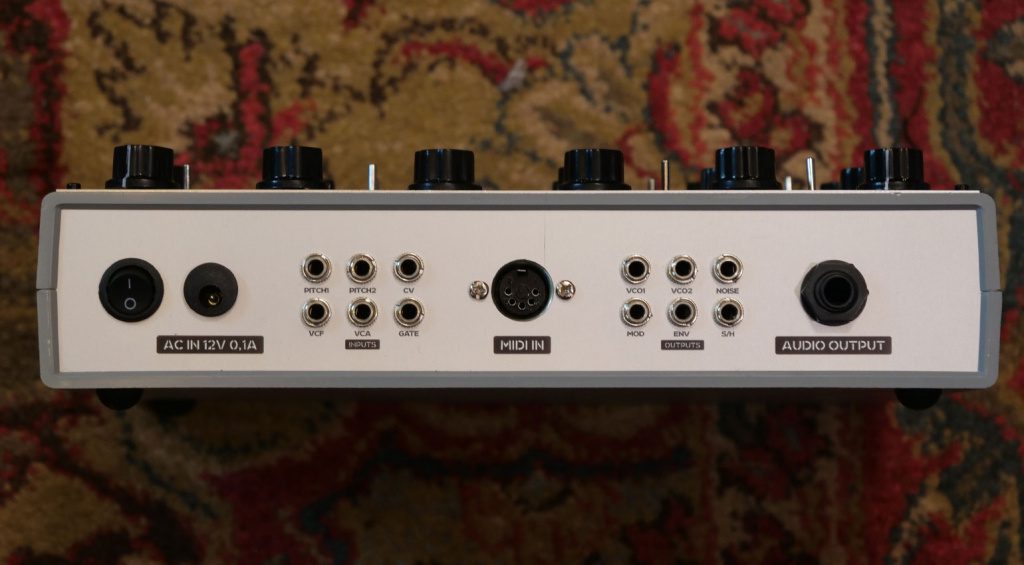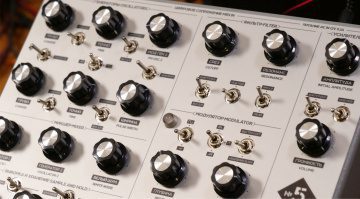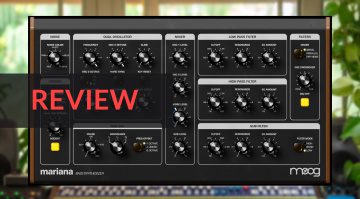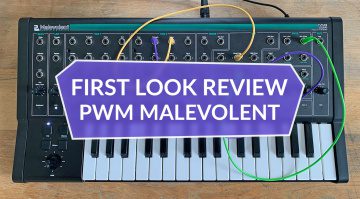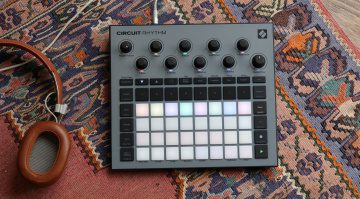Review: Sound Object #5, a Russian built beast of an analogue monosynth
Hand-built in Russia, Sound Object #5 is a desktop two-oscillator analogue monosynth with duophonic tendencies and an interesting modulation system. And it’s pure bonkers. Let’s check it out.
Sound Object #5
Starting out on my journey with this synth, I don’t really know what’s going on but I’m having a fabulous time fiddling with it. Sound Object #5 wants to play itself… No, it has to play itself. Like it’s compelled to push sound out regardless of your intentions. And the best course of action is to go with it and worry about why it’s happening later on. It lurches from beeps and boops to sweeping curves dripping with noise, to chaos, to an alien spaceship changing gear, to sirens, to revolving computer banks to where I am at the moment with one oscillator doing an arpeggiation, another one looping itself off a cliff while the filter bubbles away on some other mission. Touch anything and you’re off on another adventure – and I don’t know how I got onto this one in the first place. Oh, what’s it doing now? This is brilliant!
It seems somehow cruel to try to tame Sound Object #5 into some sort of playable synthesizer but the trick is in the switches. There are many switches that do all sorts of modulation routing types of things and you need to find their off position so the associated parameter isn’t being messed about by something. Right, now we’re getting somewhere…
The Basics
Sound Object #5 is a 2-oscillator monophonic analogue synthesizer built-in Rostov-On-Don in Russia near the tip of the Sea of Azov by Sergei Michailov and Dimitri A. It has a Polivoks style filter, a single loopable and switchable ASR/AR envelope, a single LFO and a fascinating Sample & Hold circuit. It has a VCA and an oscillator mixer which also introduces a noise generator.
The two oscillators have independent coarse and fine-tuning with a switch for Hard Sync. VCO1 has purely a sawtooth waveform whereas VCO2 can switch from sawtooth to square with a dedicated pulse width knob and modulation switch. The third knob for VCO1 feeds in VCO2 for some properly mental FM. There’s a load of tones you can pull out through a combination of FM depth, VCO2 level, square wave pulse width and tuning. The VCOs sound great, particularly in combination. The Sync has a lovely harmonic quality to it but I prefer them loose and just slightly detuned for a fabulously thick sound.
The filter is based on the Polivoks VCF and features a 12dB/Oct low and 6dB/Oct bandpass mode and has a really pleasant feel to it. There’s no drop in level when dialling up the resonance until it squeals at about 5 o’clock. The self-resonance is fierce but playable although not in a 1v/oct way – it has its own rules of melody. While you might expect a bit more grit from a Polivoks filter it does sound quite lovely.
You are currently viewing a placeholder content from YouTube. To access the actual content, click the button below. Please note that doing so will share data with third-party providers.
Right, let’s get into those modulators.
Envelopes
The Envelope has two types. It can be a triggerable AR envelope where the envelope is fired and follows the Attack and Release setting and doesn’t care if you’re holding the note. Or it can be an ASR envelope where Sustain continues for as long as the note is held before letting go into Release. There’s a manual trigger button and a Depth control which sets the amount of envelope going to any of its destinations. It would be nice if the destinations had their own depth controls as this one works on everything at once.
You can set the AR envelope looping via a switch so it becomes another LFO with the Attack and Release knobs providing the cycle length. The other option for the switch is to let the envelope be triggered by the speed of the Sample & Hold.
One envelope can be switched into the VCA, the filter cutoff, the pitch of each oscillator and as a source for the Sample & Hold circuit; it gets everywhere.
LFO
The Modulator is an LFO with 4 waveforms and 2 levels of velocity. The switch configuration is slightly odd. You can select a square wave on one switch by flicking it up or you can flick it down to select one of the other waveforms (sine, sawtooth, ramp) on another switch. Why they can’t have a 4-way switch is anyone’s guess. Rate and Depth are the only controls with a switch to move from really slow-to-moderate to moderate-to-really-fast. I find the switching point to be just around the area I like to play which is a little annoying. But it does go all the way down to hardly moving and all the way to audio rate.
The Modulator can also switch into any of the other parameters and be used at the same time as the envelopes.
Sample & Hold
Sample & Hold is always a slightly strange process and this module is definitely what gives Sound Object #5 its unique and playful character. The switches at the top, again in a slightly quizzical arrangement, let you choose your source from Noise, Modulator or Envelope. This is quite interesting because you’d usually expect S&H to use the noise generator to grab onto a random value, but with the envelope and LFO it would be sampling and holding a value from the rise and fall of modulation. This turns the S&H into a sort of arpeggiator or sequencer depending on the speed of what it’s sampling. Give it a sine wave LFO and you get climbing and falling notes; it’s really rather good.
The Input Level knob gives you the range of the sampling while the Sample Rate knob gives you the speed at which it happens. The Sample Rate is a little strange because it’s very slow from all the way left to way past 12 o’clock and then all the speed is packed in between 3 and 5 o’clock. The third knob, Slide, lets the sampled values slew towards each other rather than step.
Connections
On the back, everything gets a CV input and a signal output via the 6 in and 6 out patch points. There’s a MIDI input for your keyboard and a single mono audio output on a 1/4″ jack.
The MIDI is simple enough with pitch, note on/off and mod wheel routed to the filter cutoff. There doesn’t appear to be any other implementation going on.
On the CV side, things start to get really interesting. Well, at least there’s one bit that’s really interesting. The rest is what you’d expect. You’ve got individual outputs for both VCOs, the Noise generator and then all 3 modulators so you can use the envelope, LFO and S&H on other stuff. On the input side, you’ve got CV control over the filter and VCA. And then it gets all a bit duophonic.
You have individual pitch inputs for both VCOs. This means you can play the pitch of each VCO independently making Sound Object #5 unexpectedly duophonic. There’s only the one Gate input so it doesn’t actually have two voices as both VCOs go through the same filter and VCA section. But it does let you run two melodies which is rather fabulous.
You are currently viewing a placeholder content from YouTube. To access the actual content, click the button below. Please note that doing so will share data with third-party providers.
The other CV input controls the pitch of both VCOs like a regular monosynth.
With these additional connections, you can process the VCOs separately, route modulators out to different gear, run two melodies with a separate gate sequence while transposing over MIDI – that’s phenomenal. I would have liked to have the CV patch points on the front panel but you can’t have everything.
Conclusions
There’s loads of fun and character to be found in Sound Object #5. While it handles being a 2-oscillator analogue monosynth really well it excels in unexpected adventures in modulation. It’s very playable and easy to work with even if you’re not sure exactly what’s going on all the time. You have a lot of scope in the tone department with single or combined waveforms, sync, FM, PWM and detuning on offer between the 2 VCOs. Being able to pull them apart via CV into individual melodies is fabulous. You will need to keep re-tuning those oscillators if you like to mess with different tones in the same track and it doesn’t take much to accidentally nudge a tuning knob into dissonance.
On the physical side, the box is plastic, although it doesn’t twist or flex and feels pretty solid. Those knobs are fairly loose and do have a bit of play in them which makes you feel that this isn’t a premium product, and it’s not. Sound Object #5 is cheap and cheerful but in all the right ways.
Sound Objects were sought out by Anna Martinova of the Modular Moon school of modular and they’re working together on bringing these synths to a wider audience. Anna said that she was looking for something affordable for her students to buy as part of their exploration of synthesis. Sound Object #5 definitely fits the bill. It was Anna who got them to add English labels and add some patch sockets and she’s working with them to up the quality with every production run. She’s also produced some excellent manuals and patch guides which is not something you’d find from some other budget synth makers. I’m really glad they kept the Russian labels on there too because it gives it a certain vibe.
All the Sound Object synths are built and tested by hand and so it can take a couple of weeks to supply. At €350 it’s really affordable and is definitely a little bit different.

 5,0 / 5,0 |
5,0 / 5,0 | 